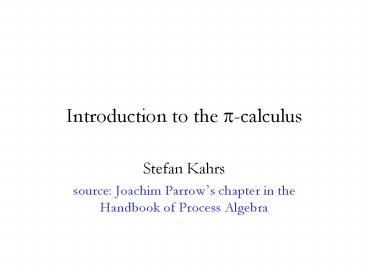Introduction to the calculus - PowerPoint PPT Presentation
1 / 26
Title:
Introduction to the calculus
Description:
Name creation is internal to the calculus ... other bisimulations: barbed, early, open,... also: weak bisimilation, i.e. making unobservable ... – PowerPoint PPT presentation
Number of Views:69
Avg rating:3.0/5.0
Title: Introduction to the calculus
1
Introduction to the ?-calculus
- Stefan Kahrs
- source Joachim Parrows chapter in the Handbook
of Process Algebra
2
What is it?
- In short a process algebra, invented by Robin
Milner around 1990. Process algebra are like toy
programming languages for parallel programming - Special features
- Name creation is internal to the calculus
- Orthogonality names serve both as data and as
channels (mobility)
3
Syntax
- P P1 P2 parallel
- P1 P2 n.d. choice
- (?x)P new name
- x1(x2). P input
- x1 x2 . P output
- 0 stop
- ? . P silent action
- A(x1,,xn) defined process
- if x1x2 then P match
- if x1?x2 then P mismatch
4
Slight Variations
- the original paper by Milner et.al. had match but
not mismatch some papers omit both - instead of (recursively) defined agents, some
papers have replication (!P) instead of recursion - at least one paper omits non-det. choice
- syntactic variants xyP, (x)P, ?x.P
5
Standard Process Algebra Stuff
- communication on a channel a
- notice this is synchronous, but...
- aside substitution avoids name capture
6
...and also
- process descriptions of A(x1,...,xn)
- note the xi are just name parameters
- can be (mutually) recursive
- no renaming operator
7
Names
- The distinguishing feature of the ?-calculus!
- originated in Standard ML semantics
(implementations) - type checking (for datatypes or abstract types)
- exception constructors
- not fundamentally different from object creation
in OO-programming
8
Eh?
- the ? operator generates a new name
- or if you prefer hides a free name
- however these names are mobile communication
can move them into other areas that seemingly
were outside the scope - this is achieved by the congruence relation which
equates (some) equivalent processes
9
Example of moving scope
- on the left ? inside parallel composition
- on the right it has moved outside
10
Congruence ? (note Parrow)
- ? is the smallest congruence such that
- both and form commutative monoids with
neutral element 0 - it includes ?-conversion
- ...and the unfolding of definitions
- ...and most importantly, the scope extension laws
11
Scope Extension Laws
garbage collection
12
Consequences and non-Consequences
- all binders can be moved to the top only
recursive descriptions are in the way - we do not have
- it should be clear why however, for we do not
have this either and there it is less clear
13
Operational Semantics
- defines a labelled transition relation
- when we have
- ...then t can evolve to u, and the outside world
can observe the action ? - three actions
- input a(x)
- output
- silent ?
- one of many presentations...
14
Rules I
15
Comments
- because of the input prefix (also ?x labels, but
they play only a minor rule) there are bound
names in labels - non-deterministic choice commits by making a
transition (which can be silent), and this is the
only thing it can do
16
Rules II
17
Comments
- because of the side-condition on the RES rule,
any attempt to immediately send or receive on a
fresh name will deadlock - the CLOSE rule is not really necessary, because
its effect can be achieved through the other
rules, but without it the OPEN rule would fire
blanks
18
Bisimulation
- ...cannot quite be defined as usual, because we
have two problems - bound names in labels
- even if we take care of them, we do not get a
congruence relation
19
Reminder Standard Definition
- a (strong) bisimulation is a symmetric binary
relation ? such that if and P?Q
then ?Q. and P ? Q. - modification for input prefix (?a(x))
- assume x is fresh and
- write P?Q if it holds for some bisimulation
20
Input Prefix
- may not preserve strong bisimilarity
- because ? is not preserved by (arbitrary)
substitutions an aliasing problem - ...and input prefix can introduce aliasing
21
Example
- is bisimilar to
- but the substitution b/a would break the
equivalence since the left could silently evolve
to 0, the right cannot - therefore, the input prefix c(a) breaks
bisimilarity as well
22
Getting out of jail
- two agents P and Q are (strongly) congruent if
and only if P? ? Q? for all substitutions ?. - note strong congruence is the largest congruence
relation in bisimilarity - other bisimulations barbed, early, open,...
- also weak bisimilation, i.e. making ?
unobservable
23
Asynchronous ?-calculus
- As most process algebras, the ?-calculus is
essentially synchronous. - However, when we constrain the agents we can
write in a certain way, we end up with an
asynchronous calculus. - What are the constraints?
24
Constraints for asynchronous calculus
- Only 0 can follow an output prefix
- an output prefix may not occur as an unguarded
operand of - Rationale the agent ?.(ax.0 P) is essentially
asynchronously outputting on a and continuing as P
25
Recover...
- it is possible to recover from these constraints
by using acknowledgements, e.g. - the binder protects the name b and thus protects
the acknowledgement
26
Lots of other stuff
- if others are willing to continue that theme...
- PICT, a programming language based on the
asynchronous ?-calculus - proving (various) bisimilarities
- applications
- higher-order ?-calculus
- action semantics































